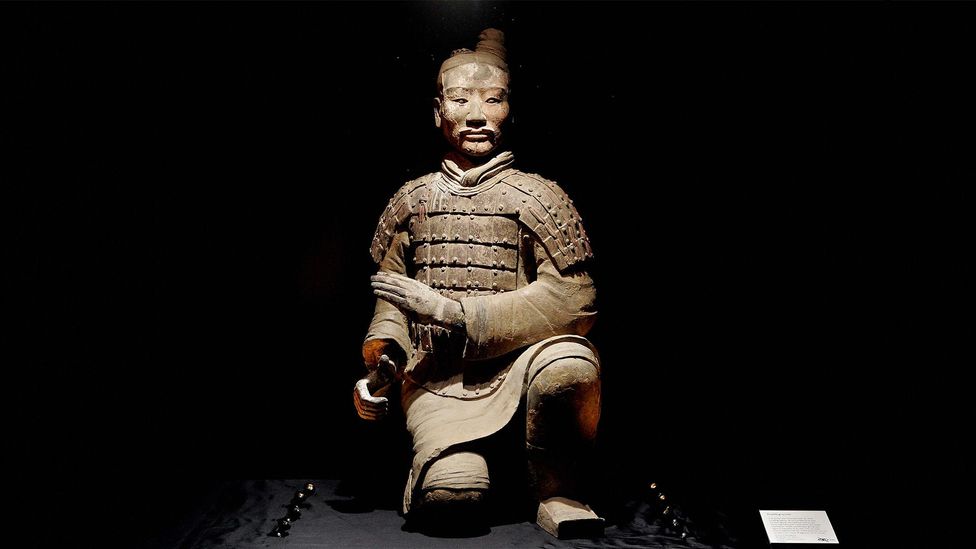They don't talk. They can't move. But the enigmatic terracotta warriors of China are excellent storytellers.
Since they were accidentally discovered 50 years ago by a group of farmers digging a well, these life-size clay figurines have revealed intriguing details about the soldiers of Qin – the feudal state that unified China, for the first time in 221BC under the country's first emperor Qin Shi Huang.
Detailed examination of the warriors, which were discovered in buried pits to the northeast of Xi'an near the tomb of the emperor, have shed light on what life during the ancient Qin Dynasty was like, from the clothes people wore to where soldiers in the army were from.
Shoes may not be the first thing one would notice of these 2,200-year-old sculptures, armed with real weapons and arranged in military formation to guard Qin Shi Huang in his afterlife. But a preliminary analysis of their footwear showed that these humble accessories might have played a "vital role" in the Qin army, and contributed to their ability to achieve victory after victory.
Two Chinese researchers behind the study, which has yet to be peer-reviewed or published in a scientific journal, analysed the shoes of a kneeling archer, the only type of terracotta warriors excavated so far which reveals the sole of their shoes. They then made a copy of the footwear using the shoe-making techniques and materials known to be used by the Qin people when the warriors were constructed.
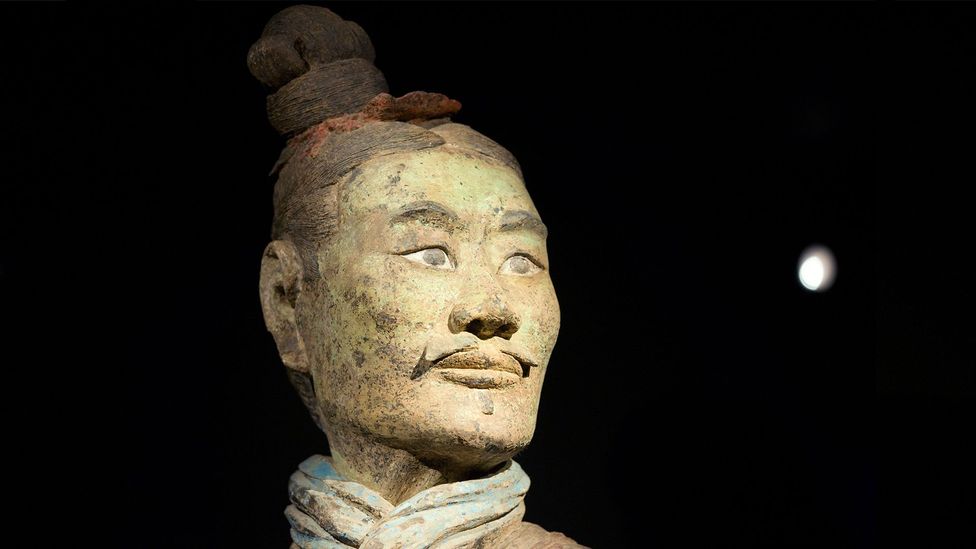
The warriors were first unearthed after a chance discovery from a farmer in the 1970s (Credit: Alamy)
The study compared the reproduced shoes with two pairs of modern “thousand-layer” shoes and found that the replicas were extremely flexible and provided the wearers with "a more comfortable, stable and efficient" walking experience. Their soles also demonstrated better slip resistance in wet conditions.
The shoes' "unique production processes and superb artistic skills were breathtaking", says Cha Na, a co-author of the paper and graduate student with the College of Biomass Science and Engineering at Sichuan University in Chengdu.
What surprised Cha most was the shoe sole, known as the "thousand-layer" sole, which comprised several layers of ramie sheets glued, stitched and then pounded together.
The absorbent fabric used in the sole would have also helped the soldiers in wet or humid conditions
"When I held the modern replicas of what could have been worn by Qin soldiers more than 2,000 years ago, I was deeply impressed by how exquisite they were," Cha says. "[I] could clearly see the stitches which were pressed through the 'thousand-layer' soles and lined up neatly. The soles were extremely soft and comfortable and could be bent very easily."
The kneeling warrior's sole was divided into three sections, with each carrying different numbers of stitch holes: the forefoot section had the densest patterns, the heel the next and the midfoot the least. This design was also reflected in the researchers’ replicas. They say the detail was based on the needs of the human foot and aimed at providing "optimum comfort, support and durability".
The absorbent fabric used in the the sole would have also helped the soldiers in wet or humid conditions, giving them a non-slip shoe that would have allowed them to move nimbly on difficult terrain.
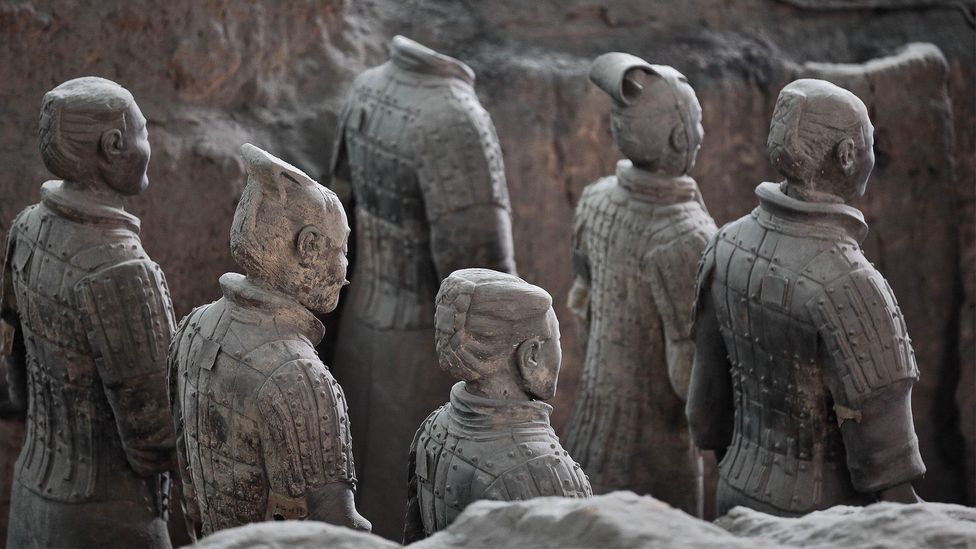
The warriors are noted for their lifelike detail, including the exceptionally accurate ears (Credit: Alamy)
"Although shoe soles are small, they play a key role in [helping us] understand ancient lifestyles, craftsmanship and cultures," Cha says.
Equally fascinating are the warriors' clothes: they were candy-coloured.
When the terracotta warriors were originally created, they were painted a bright array of reds, purples and greens, which are believed to have matched the colours of the clothing worn by the Qin soldiers themselves. In many cases, the paint has not survived the centuries after the warriors had been scorched by fires or soaked in floods, but a few of the warriors have been unearthed with their original colouring still largely intact.
These freshly unearthed terracotta warriors often had vividly coloured facial features, hair and clothing. But once the warriors are exposed to the environment, their paint would get dehydrated and peel off within minutes, leaving the naked clay beneath. A 2019 study found that the pigments originally were mixed with various protein-based binders, such as egg, animal glues and milk, before being painted onto the soldiers to help secure the paint. The study also found that different sculptures carried different paint binders, indicating that those who painted the figurines had likely found the materials locally or used their own habits during the production process.
The lacquer used on the fired clay before it was painted – made from a processed tree sap – is highly sensitive to changes in humidity and so dries and flakes off easily, taking the paint with it. But scientists and conservation experts have been developing ways to preserve the polychromatic patterns.
All ranks of warriors sported tops and bottoms with eye-popping colour combinations
Microscopic and chemical examination of the paint found on other warriors have also provided further insight into what they would have looked like before they were buried.
Reconstructions based on this research seem to suggest the Qin fashion – at least in the army – was to clash colours. All ranks of warriors sported tops and bottoms with eye-popping colour combinations, according to Yuan Zhongyi, one of the first archaeologists sent to the excavation site in 1974.
Yuan, dubbed the "father of terracotta warriors" by Chinese media, described in detail the colours of the warriors' costumes in a paper published in 2001. He said that one general had been found wearing a scarlet long inner coat, a dark purple long overcoat and a pair of pink-green trousers. His outfit was completed with a brown crown, black shoes, plus multi-coloured armour fastened with scarlet strings.
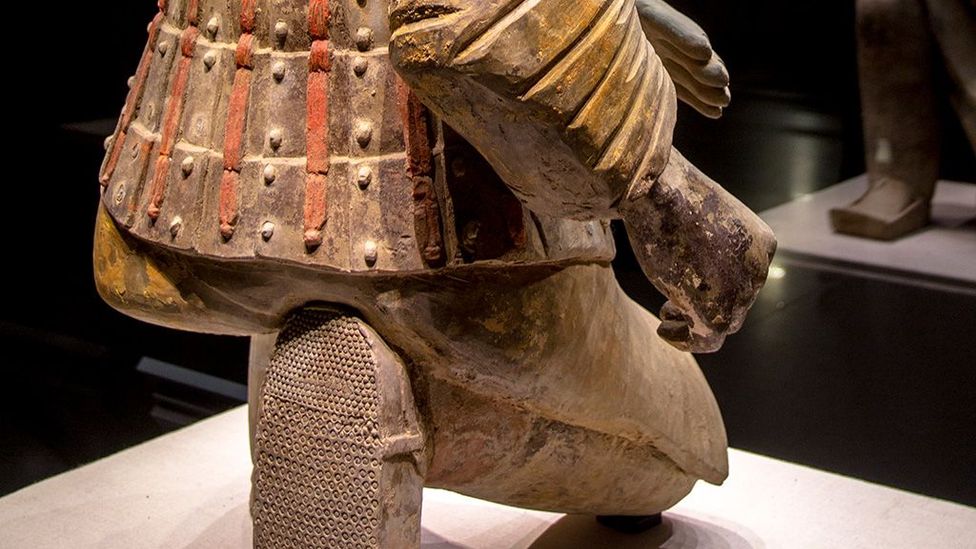
The exceptionally detailed shoes show that Qin's real-life army used footwear that offered similar abilities to some modern shoes (Credit: Getty Images)
Another kneeling warrior was unearthed dressed in a long green overcoat with a scarlet collar and scarlet cuffs, blue trousers covered with purple leg protectors, a scarlet headband and brownish-black shoes, according to Yuan.
Yuan cited two letters written by two Qin soldiers, excavated in an ancient tomb in modern-day Hubei province. The two letters, carved on bamboo slips, show the servicemen, who were brothers, asking their family to send them money and clothing.
There are other clues that the 7,000-strong clay army may have been modelled on real people
Among the more than 10 hues archaeologists have found on the relics, the most enigmatic is purple – a complex synthetic dye.
Some researchers have suggested that Taoist monks accidentally came across the "Chinese purple" pigment – as well as the related "Chinese blue" which is also found on terracotta warriors – while making artificial jade from glass. They believe the monks were experimenting with adding different copper-containing minerals to barium.
Yuan's research indicates that purple was one of the four most popular colours for clothes among the Qin people, together with green, red and blue.
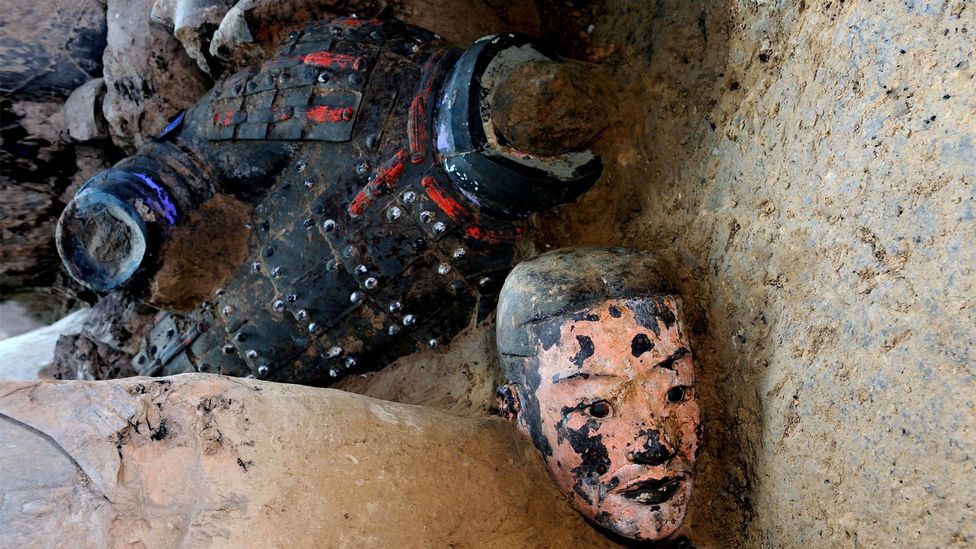
When the warriors were originally constructed their clothing was painted in a riot of colours; some figures still hint at its vibrancy (Credit: Getty Images)
Although there were no historical records of the existence of the terracotta warriors – meaning they stood forgotten in Qin Shi Huangs necropolis for more than two millennia – there are other clues that the 7,000-strong clay army may have been modelled on real people.
One study that examined 30 of the statues' ears discovered "considerable variation" in the shapes to the extent that "no two ears are strictly the same".
In 2022, a group of researchers analysed the facial features of 58 warriors and 29 modern Chinese ethnic groups, such as Mongolia, Jingpo and Xibo. They found that the warrior's features "highly resemble" those of contemporary Chinese people, which the researchers say indicates the statues were based on real portraits. The study revealed the sculptures looked most like people found in northern and western China.
Li Xiuzhen, an archaeologist at University College London who took part in both studies, says that the Qin people originated in the western part of China. Part of their army was formed by the Rong people, various nomadic tribes living in the north-west who had been conquered by Qin.
More like this:
• The puzzle of Neanderthal culture
• The shipwrecks rewriting history
• The Maya secrets spotted from the sky
The Rong fought for Qin to defeat six rival states, says Li. "Therefore, many terracotta warriors had the Rong people's facial features," she says.
Such findings reinforce the idea that the vast mausoleum at Xi'ian army was created to replicate the armed forces that served the Qin Emperor during his life so they could protect him in the afterlife. The huge numbers of bronze weapons, including 40,000 arrow heads, were discovered in the pits with the warriors, only serve to support this theory.
Although only around 2,000 terracotta warriors have been excavated to date, more are being uncovered with each passing year. It may take a long time to excavate all terracotta warriors, according to Chinese archaeologists. And as they are exhumed from their tombs, their secrets will continue to reveal new insights into life in the ancient China of the Qin Dynasty.
But it's already clear that the skill and workmanship that went into creating them is just as formidable as the military force the unmoving warriors represent.
"Our research demonstrated once more that those who made the terracotta warriors were not just workmen, but artists that created their artworks based on reality," says Li.
--
If you liked this story, sign up for The Essential List newsletter – a handpicked selection of features, videos and can't-miss news delivered to your inbox every Friday.
